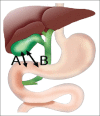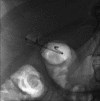EUS-guided gallbladder drainage: A review of current practices and procedures
- PMID: 31897376
- PMCID: PMC6896434
- DOI: 10.4103/eus.eus_41_19
EUS-guided gallbladder drainage: A review of current practices and procedures
Abstract
EUS-guided gallbladder drainage (EUS-GBD) is utilized for the treatment of acute cholecystitis and symptomatic cholelithiasis in patients who are poor operative candidates. Over the last several years, improved techniques and accessories have facilitated GBD. Recent literature demonstrated effectiveness and safety of EUS-guided GBD. Available data suggest at least similar results when compared to percutaneous cholecystostomy. EUS-guided GBD can be performed as a primary intervention in patients with cholecystitis who are unfit for urgent surgical intervention and as a secondary intervention to internalize biliary drainage in patients with indwelling percutaneous cholecystostomy catheters. Various stents can be used for -EUS-guided GBD. The optimal device and technique have yet to be determined, although at the present time, the use of luminal apposing stents is preferred. The purpose of this review is to provide the highlights of the most recent literature on EUS-guided GBD.
Keywords: Cholecystitis; ERCP; EUS; endoscopic retrograde cholangiography; gallbladder drainage.
Copyright: © 2019 Spring Media Publishing Co. Ltd.
Conflict of interest statement
Dr. Baron is a consultant and speaker for Medtronic, Boston Scientific, W.L. Gore, Cook Endoscopy and Olympus America.
Figures




References
-
- Friedman GD. Natural history of asymptomatic and symptomatic gallstones. Am J Surg. 1993;165:399–404. - PubMed
-
- Roslyn JJ, DenBesten L, Thompson JE, Jr, et al. Roles of lithogenic bile and cystic duct occlusion in the pathogenesis of acute cholecystitis. Am J Surg. 1980;140:126–30. - PubMed
-
- Csendes A, Burdiles P, Maluenda F, et al. Simultaneous bacteriologic assessment of bile from gallbladder and common bile duct in control subjects and patients with gallstones and common duct stones. Arch Surg. 1996;131:389–94. - PubMed
-
- Singer AJ, McCracken G, Henry MC, et al. Correlation among clinical, laboratory, and hepatobiliary scanning findings in patients with suspected acute cholecystitis. Ann Emerg Med. 1996;28:267–72. - PubMed
-
- Reiss R, Nudelman I, Gutman C, et al. Changing trends in surgery for acute cholecystitis. World J Surg. 1990;14:567–70. - PubMed

